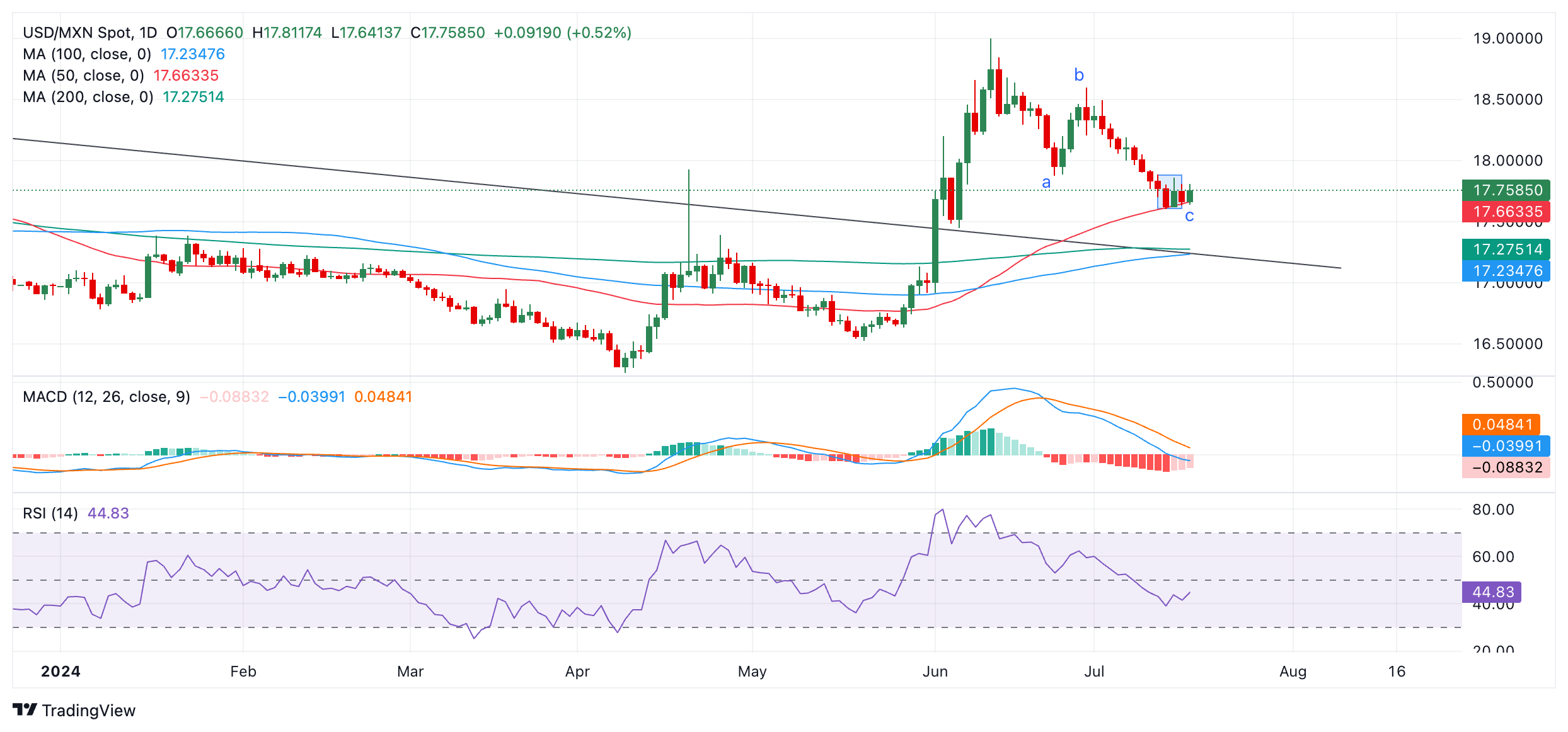- The Mexican Peso trades variably against its main counterparts amid data releases and changing interest rate expectations.
- MXN is rising against the USD as bets on a September rate cut mount; versus European currencies, the Peso lags.
- Stubbornly high inflation in the old continent could delay rate cuts from the BoE and ECB, supporting European FX.
The Mexican Peso (MXN) is trading mixed against its key counterparts on Wednesday. MXN is rising versus the US Dollar (USD), which has weakened due to increasing bets the Federal Reserve (Fed) will lower borrowing costs in September. This, in turn, has weighed on USD since lower interest rates attract less foreign capital inflows.
Against the Pound Sterling (GBP), the Mexican Peso is weakening after UK Consumer Price Index (CPI) data showed inflation remained stubbornly high in June. This suggests the Bank of England (BoE) could delay cutting interest rates in the UK. The same is true of EUR/MXN, which is up over a percent after the release of Eurozone inflation data showed similarly persistent inflation in the region.
At the time of writing, one US Dollar (USD) buys 17.73 Mexican Pesos, EUR/MXN trades at 19.41, and GBP/MXN at 23.12.
Mexican Peso trades mixed depending on counterpart
The Mexican Peso is rising versus a weaker USD after a speech from the Fed Board of Governors’ member Adriana Kugler in which she said the Fed might cut rates “later this year”. Markets interpreted this as further confirmation of an interest rate cut in September.
“It will be appropriate to begin easing monetary policy later this year if economic conditions continue to evolve favorably,” said Kugler in a speech to the Peterson Institute for International Economics on Tuesday.
Kugler also added that further signs of deterioration in the labor market might provide another reason for the Fed to lower interest rates, a move which could stimulate hiring through lower borrowing costs. June’s Nonfarm Payrolls report revealed that the Unemployment Rate rose to 4.1%. It was the third month in a row that unemployment had risen in the US, and the highest level it has been at since November 2021. Unlike most central banks, the Fed has a dual mandate to achieve target inflation (of 2.0%) and “full employment”.
Her comments come on the back of market-moving statements made by Federal Reserve Chairman Jerome Powell on Monday, and a marked cooling in recent US inflation data.
Inflation in Europe remains stubbornly high
The Mexican Peso is losing ground against both the Euro and the Pound on Wednesday after the release of CPI data from both the UK and the Eurozone showed inflation remaining largely unchanged in June. This raises the possibility the Bank of England (BoE) and European Central Bank (ECB) may delay making further rate cuts as they wait for inflation to continue cooling.
UK CPI rose 2.0% on a year-over-year (YoY) basis and 0.1% month-over-month (MoM) in June, which was in line with expectations and the previous month’s reading, although the MoM data fell compared to May’s 0.3% reading. UK core CPI showed a 3.5% rise YoY, which was in line with estimates and the same as previous, according to data from the UK Office of National Statistics (ONS) released on Wednesday.
The Eurozone Harmonized Index of Consumer Prices (HICP) rose 2.5% YoY in June – the same as the previous month and in line with estimates, whilst monthly HICP rose 0.2%, also the same as expected and the previous.
Eurozone core HICP rose 2.9% YoY in June, the same as expected and previously, and 0.4% MoM, slightly above the 0.3% registered in May, according to data from Eurostat.
It is a quiet data week for the Mexican Peso, with the next key macroeconomic release not until July 22, when the National Statistics Agency (INEGI) reveals growth figures for the month of May.
Technical Analysis: USD/MXN finds support at 50-day SMA
USD/MXN has found support after its recent decline from the June 12 high.
The pair is consolidating along the line of the 50-day Simple Moving Average (SMA) at 17.65.
USD/MXN Daily Chart

It is possible USD/MXN is preparing for a reversal higher, although there is insufficient evidence yet of this, and it remains in a short-term downtrend. Given that the “trend is your friend,” this still technically favors bearish bets.
The pair, however, might have completed a Measured Move (MM) pattern, a further sign of a reversal may be on the cards.
MMs are large, three-wave zig-zags, with waves labeled A, B, and C. The end of wave C can be estimated using the length of wave A as a guide. C is usually equal to A or, at least, a Fibonacci ratio of A. C is now roughly the same length as A, suggesting the pattern could be complete or near completion.
That said, the trend remains bearish, and a break plus a daily close below the 50-day Simple Moving Average (SMA) would reconfirm the dominant short-term downtrending bias. This could lead to a probable decline to 17.27, the level of the 200-day SMA and a major multi-month trendline.
Meanwhile, the direction of the medium and long-term trends remain in doubt.
